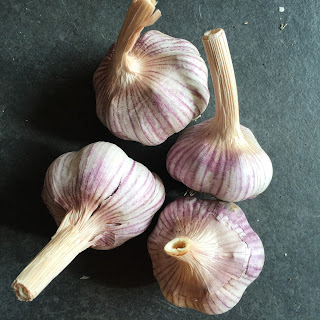Garlic by Barbara Sanders
So you think you have finished gardening because the Aspen leaves are starting to turn?
One chore remains: planting garlic!
There are basically 2 kinds of garlic: Hardneck and softneck. The hardneck variety has bigger cloves, is spicier, but stores for a shorter time—3 to 5 months. The beautiful braids of garlic that you might see are softneck which has smaller cloves, is milder and stores for about 6 to 8 months. There are several varieties of hardneck and softneck garlic: Rocambole, Purple Stripe, Porcelain, Artichoke, Silverskin, Asiatic/Turban, and Creole. My favorites: Music is my favorite in the Porcelain Family; in the Purple Stripe Family, Persian Star and Metechi; and in the Rocambole Family, Killanrney Red which doesn’t keep too long. I like garlic with large cloves, strong taste, and and one that does well in a cool, wet growing season. I just cooked a dinner with a from-the-garden Music after weeklong cure so it was still quite moist, and dinner was wonderfully pungent!
For seed garlic search for a supplier on the web who can explain the different varieties and how they compare in taste and storage. My favorite site is Filaree Farm. Much more information is available at the CSU Extension Blog: http://csuhort.blogspot.com/ and search for Garlic.
If you have a whole bulb of garlic, you must gently separate the individual cloves for planting, called popping. Twist the top of the bulb to find the individual cloves. Keep the papery skins on the clove as they protect the clove from moisture and rot. The larger cloves will produce larger bulbs.
The cloves must be planted a few weeks before the ground freezes so they can start some roots. Garlic likes soil that has been amended so it is loose and well draining. Plant the cloves in full sun or partial shade, pointy side up, about 2 to 3 inches deep and about 4 to 6 inches apart. Cover with soil and water to reach deeper than the clove and only as much as needed to keep the bed from drying out. The fall rains should be plenty. A mulch of leaves or straw will protect from frost heaving. Snow is also a good insulator against hard freezes.
So that is how to plant garlic at the end of gardening season. Once the snow melts, the plants will be up and waiting for your attention during the summer.
Barbara Sanders and her husband moved to Steamboat from Hawaii in 1997. She learned about Colorado plants and trees through the Master Gardener program and while volunteering at the Yampa River Botanic Park. Barbara finds native plants most interesting as “they are adapted to our crazy, changeable climate and to our different soils” and her vegetable garden the most fun, which she tends with her husband, Bill.
